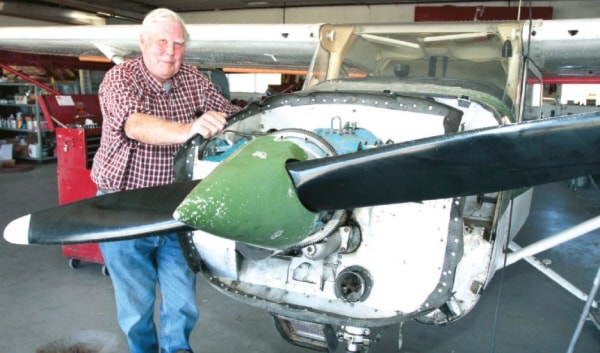When work and play combine, for most people it is a dream come true. With 60 years in aviation, for Lewis Ervin it is a story worth telling.
He tells the story of being eight years old and telling a friend he would one day be a pilot, and he was. On Sept. 16, 1952, Ervin was sworn into the Royal Canadian Air Force (RCAF) in Edmonton.
“I was very fortunate, I would spend 30 years with the air force. If I could do it all over again I wouldn’t change a thing,” said Ervin.
After being posted at the RCAF Station MacDonald in Portage La Prairie, Man., Ervin was transferred to Winnipeg where he became a qualified technician on various planes including the Lockheed T-33 fighter jet.
Eventually he was transferred to Comox, B.C. where he mainly flew in Albatross aircraft for search and rescue, which is when he found himself in a helicopter.
He had a challenge learning how the CH113 Labrador helicopter worked. “I thought it was going to be easier than it was until the first day when I suddenly found out that the whole damn theory of flight was different…the only difference between a helicopter and the fixed wing is that the rotor disk is actually the wing,” he explained.
After a six-week course on how the helicopter operated, Ervin was able to properly maintain the helicopter. He became a part of search and rescue operations. Before the advent of Emergency Locator Transmitters (ELT) in 1970, rescue teams would search for fallen aircraft without electronic assistance.
Search and rescue in the Prairies was less challenging than in the mountains of British Columbia where the terrain was rougher, he explained.
“Of course we carried civilian spotters and things like that. You were good for about 15 or 20 minutes maximum in the window,” he said. “Ask any teacher or trainer. They’ll tell you, ‘If you teach over 25 minutes you’re going to lose your students.’”
Spotters would eventually become fixed on a certain point and crews would lose search effectiveness. He believes the real danger for search and rescue crews is if the pilot becomes more involved with search than with piloting the aircraft. “What happened was the pilot forgot to fly the airplane.”
Rescue operations could go from 15 days to his longest stretch of 59 days when crews searched for missing pilot Bob Gauthier — in the winter of 1966 and 1967 — who was en route to Yellowknife from Cambridge Bay, NWT.
Gauthier was eventually found and Ervin gained valuable experience on rescue missions in the cold north. “It’s a tough environment when dealing with piston-driven aircraft.”
His responsibility was to warm up the plane at 6 a.m. before a 9 a.m. sunrise and to ensure the pilot could fly it safely.
Dealing with 100 weight oil and no hangars for maintenance was always a challenge — especially if the Herman Nelson heaters stopped working. “You had to get creative.”
For search and rescue missions though, the attitude from the crew and crew leaders was dedication to the job.
After some encouragement from his wife, Ervin acquired his pilot’s licence in 1974 and took his first solo flight at Campbell River, B.C.
In 1974 Ervin took a six-month course on the C130 Hercules aircraft in Trenton, Ont., after being promoted to sergeant. Working in the Hercules, crews went on missions to different parts of the world for United Nations and NATO, as well as on supply missions to the Arctic base Alert in Nunavut.
“Working with the Hercules in the winter I thought I’d died and gone to heaven,” he stated.
The Hercules was suitable and easier to handle in cold weather and crews flew the four-propeller plane around the world, from New Zealand to South America, Africa and Europe, explained Ervin.
His love of planes has transferred to his children with some of them also becoming licensed. Daughter Lynn Ervin said her dad helped develop her love of airplanes. “I also got his sense of adventure…that’s what sticks with me. That he could enjoy those experiences and have a sense of exploration.”
She became well acquainted with airplanes at a young age and much of her work involves airplane trips. “I actually learned how to fly before I learned how to drive.”
Her father started Ervin Aviation Enterprises in 1979 when he leased his Cessna 150 CF-WKE, which was purchased five years earlier. It helped put three of his four children to train for a private licence.
Ten years later Ervin started working for Glen Park at Park Air Services, which has been in operation in Ponoka for 47 years. He purchased Park Air in 1991 and has been working on planes since then. His other company, Ervin Aviation, started a flight school in 1996 in Ponoka and flight students trained for recreational permit, private pilot licence, and commercial pilot licence along with visual flight rules (VFR) over mountaintops, mountain flying and night endorsement.
Much of that changed after Sept. 11, 2001 with insurance rates almost tripling for his two aircraft.
It was no longer a viable option, so the flight school closed. “I still say I enjoy what I’m doing and I’ll do it as long as I can,” he stated.
If the weather is decent, Ervin commutes to work with his Cessna 150 from Stony Plain; the flight usually takes 45 minutes.
